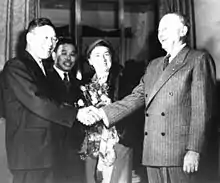Dodge Line
The Dodge Line was a financial and monetary contraction policy drafted by Joseph Dodge for Japan to gain economic independence after World War II.[1] It was announced on March 7, 1949.

Hayato Ikeda meeting Dodge (right) in 1948
It recommended:
- Balancing the national budget to reduce inflation
- More efficient tax collection
- Dissolving the Reconstruction Finance Bank because of its uneconomical loans
- Decreasing the scope of government intervention
- Fixing the exchange rate to 360 yen to one US dollar to keep Japanese export prices low
Dodge had the Reconstruction finance bank, which was a major conductor of inflation-financed subsidies, shut down. He took important steps to restore Japan's foreign trade to private hands. The terms of all transactions were determined at the unchanging official exchange rate of $1 = 360 yen.
References
- Savage, J.D. (2002-06-01). "The Origins of Budgetary Preferences: The Dodge Line and the Balanced Budget Norm in Japan" (PDF). Administration & Society. doi:10.1177/009539902400387191.
This article is issued from Wikipedia. The text is licensed under Creative Commons - Attribution - Sharealike. Additional terms may apply for the media files.